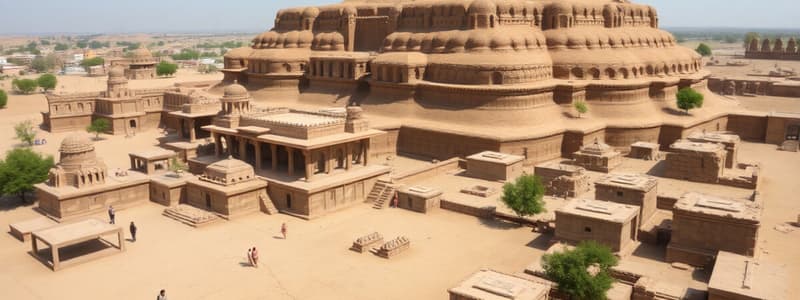Podcast
Questions and Answers
What was a major characteristic of the urban planning in Harappan Civilization?
What was a major characteristic of the urban planning in Harappan Civilization?
- Circular street layouts
- Unorganized residential areas
- High-rise buildings
- Grid patterns in city layouts (correct)
Which crops were primarily cultivated in the Harappan economy?
Which crops were primarily cultivated in the Harappan economy?
- Maize and beans
- Wheat, barley, and cotton (correct)
- Potatoes and tomatoes
- Rice, millet, and sugarcane
What remains undeciphered about the Harappan Civilization?
What remains undeciphered about the Harappan Civilization?
- The architectural styles of their cities
- The trade routes used
- The social structure of their society
- The Harappan writing system (correct)
Which factor is theorized to have contributed to the decline of the Harappan Civilization?
Which factor is theorized to have contributed to the decline of the Harappan Civilization?
What evidence indicates the Harappan Civilization had an advanced trade system?
What evidence indicates the Harappan Civilization had an advanced trade system?
What does current evidence suggest about the social hierarchy of the Harappan Civilization?
What does current evidence suggest about the social hierarchy of the Harappan Civilization?
Which major cities were central to the Harappan Civilization?
Which major cities were central to the Harappan Civilization?
What aspect of Harappan craftsmanship is noted in archaeological findings?
What aspect of Harappan craftsmanship is noted in archaeological findings?
Flashcards
Harappan Civilization
Harappan Civilization
A civilization that flourished in the northwestern region of the Indian subcontinent, also known as the Indus Valley Civilization.
Harappan Civilization Time Period
Harappan Civilization Time Period
The period when the Harappan Civilization thrived, estimated as between 3300 BCE and 1300 BCE.
Harappan Agriculture
Harappan Agriculture
A vital part of the Harappan way of life, including crops like wheat, barley, and cotton, which likely formed the basis of their economy.
Harappan Trade Network
Harappan Trade Network
Signup and view all the flashcards
Harappan Urban Planning
Harappan Urban Planning
Signup and view all the flashcards
Harappan Writing System
Harappan Writing System
Signup and view all the flashcards
Decline of the Harappan Civilization
Decline of the Harappan Civilization
Signup and view all the flashcards
Harappan Civilization Decline Theories
Harappan Civilization Decline Theories
Signup and view all the flashcards
Study Notes
Introduction to the Harappan Civilization
- The Harappan Civilization, also known as the Indus Valley Civilization, flourished in the northwestern region of the Indian subcontinent.
- It thrived between approximately 3300 BCE and 1300 BCE.
- Archaeological evidence suggests a sophisticated urban planning and advanced knowledge of technology within the civilization.
- The civilization's decline is still a subject of ongoing research.
Geographical Extent and Urban Planning
- The civilization was spread across a vast area, encompassing parts of modern-day Pakistan, India, and Afghanistan.
- Major cities like Mohenjo-daro and Harappa were remarkably planned.
- Cities were divided into distinct residential, craft production, and public areas.
- Well-organized drainage systems, public baths, and standardized weights and measures are indicators of advanced urban planning.
- Evidence of sophisticated town planning with grid patterns and well-planned streets.
Economy and Trade
- The Harappan economy was likely primarily agricultural, relying heavily on the cultivation of crops like wheat, barley, and cotton.
- Evidence suggests a complex trade network existed both inland and with other civilizations, possibly including Mesopotamia.
- Standardized weights and measures and seals suggest an organized trade system.
- Use of pottery, bronze tools, and other craft items were prevalent in the trade.
Society and Culture
- The social structure of the civilization remains a subject of debate among scholars.
- Archaeological evidence suggests societal divisions, potential priestly class, and possibly an organized social hierarchy.
- Evidence of craftsmanship, including pottery, metalwork, and seals, reveals sophisticated artistic abilities.
- Sophisticated seals, figurines, and crafts demonstrate a culturally rich environment.
Writing System and Script
- The Harappan writing system is still undeciphered.
- Seals and inscriptions on tablets bear a script that has not been fully interpreted.
- Understanding the written language would provide crucial information about the civilization's beliefs, practices, and organization.
Decline
- The exact cause of the decline of the Harappan Civilization remains a mystery.
- Theories include environmental factors, such as floods or droughts, and the possibility of invasion from the Indo-Aryans.
- Evidence suggests a gradual decline and eventual abandonment of the major urban centers.
Key Archaeological Sites
- Mohenjo-daro: A major urban center characterized by impressive urban planning and advanced sanitation systems.
- Harappa: Another prominent city, well-known for its planned layout.
- Lothal: Known for its dockyard, suggesting maritime trade.
Art and Crafts
- Complex pottery designs reflect the artistic skills of the Harappans.
- They manufactured various bronze tools and figurines demonstrating their metalworking abilities.
- Decorative items like seals and ornaments showcase the civilization's artistic flair.
- Unique seal impressions are widely recognized as important cultural markers.
Studying That Suits You
Use AI to generate personalized quizzes and flashcards to suit your learning preferences.
Description
Explore the fascinating world of the Harappan Civilization, also known as the Indus Valley Civilization, which thrived from 3300 BCE to 1300 BCE. This quiz covers geographical extent, urban planning, and the sophisticated technology of the era. Test your knowledge about one of the world's earliest urban cultures and its lasting legacy.




